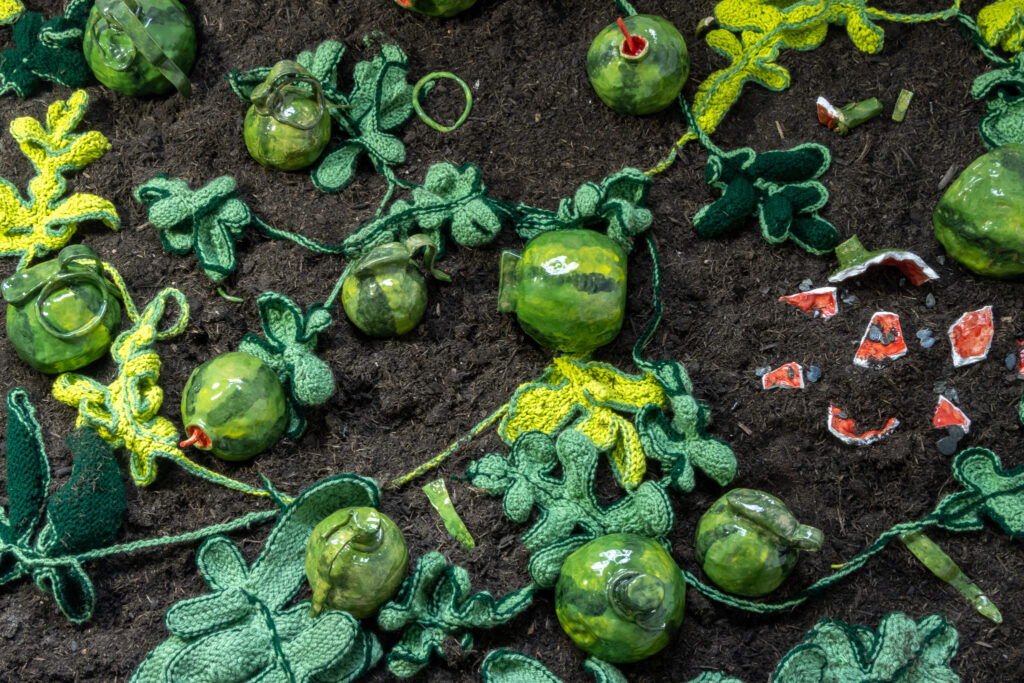Watermelon Battalion

El Assadi’s Watermelon Battalion is derived from the current reality of political censorship, speculative propaganda, and a powerful cultural resistance. As a Palestinian-Ukrainian artist who has lived most of her life outside of her countries of origin, her work researches the hidden stories of her ethnic dual backgrounds, and the intersections of both cultural traditions and historical narratives. The project consists of a large-scale sculptural installation and a para-fictional short film narrating a story connected to the oppression of both regions.
The installation presents a field of glazed ceramic watermelons in a patch of knitted leaves, together with a TV featuring a para-fictional news report. In the video, a Ukrainian-Palestinian breed of watermelons has been discovered by a British news service following an accident reported by a National Heritage Sensations (NHS) crew. According to the investigation, the artist’s father brought watermelon seeds, which had been evacuated by her grandmother from the Palestinian village of Hittin in the late 1950s, to Mykolaiv, Ukraine, where he and the artist’s grandfather cross-bred them with a local variety from Kherson. In 2022, after the beginning of Russia’s full-scale war in Ukraine, the watermelon fields occupied by the Russian army started mimicking the remnants of munition, deceiving and complicating the navigation capabilities of the occupying forces.
Not accidentally, watermelon as a symbol has become a connecting point during the recent events in Palestine and Ukraine. In Palestine, Israeli forces have continuously attacked Palestinians with tear gas for the offense of simply carrying the Palestinian flag. This has led to the mass use of the watermelon as a symbol of Palestinian resistance due to the shared colors—green, white, black, and red. Meanwhile, in Ukraine, watermelon became a symbol of the local victory after the liberation of Kherson, a region known for its large-scale watermelon cultivation. In search of the dialogues between the cultural codes, El Assadi simultaneously reaches common ground for transnational solidarity: both Ukraine and Palestine suffer from the ongoing occupation and invasion by neighboring states (Russia and Israel) which deny their statehood. The piece speaks to trans-ethnic discussions and actions toward a decolonized world.
Text by Milena Khomchenko.
Alina El Assadi
is a Palestinian-Ukrainian artist based between the United Arab Emirates and the United Kingdom. She holds BFA from University of Sharjah and is currently pursuing the advanced MFA at Kingston University London. Her interdisciplinary practice ranges from moving image to installation, printmaking, photography, and sculpture. Formerly, her practice focused at the intersection of fiction and non-fiction narratives, and the history of the abandoned places in the Emirates. More recently this has developed into investigation of topics of multinational identity and belonging. Her work has been exhibited at the Thirty-Seventh Annual Emirates Fine Arts Society in Sharjah Art Museum (Sharjah, 2021), Dior Young Talent Photography (Arles, 2021), Stanley Picker Gallery (London, 2022), Dorich Museum (London, 2022), and the Xposure International Photography Festival (Sharjah, 2023).
